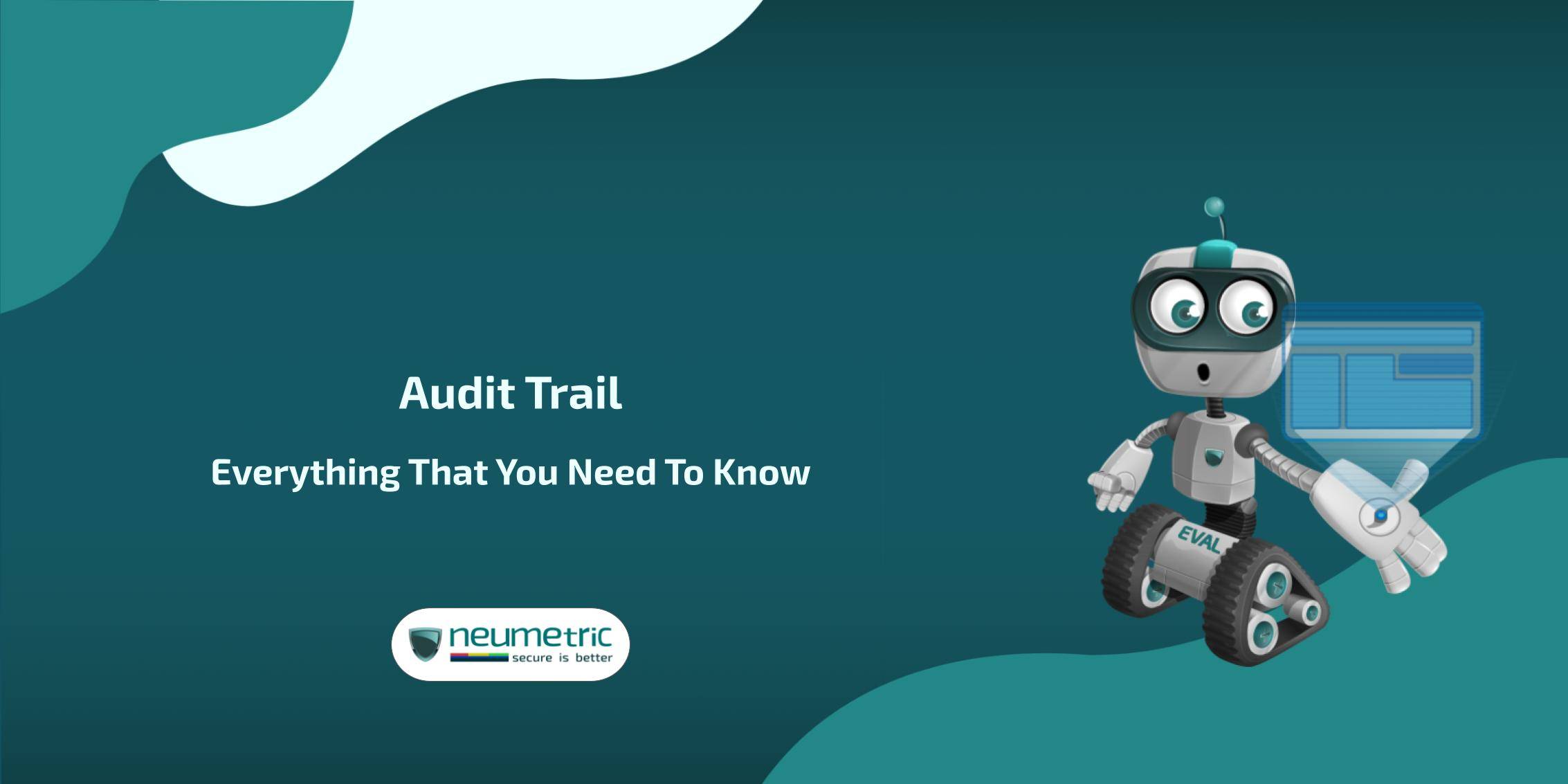Table of Contents
ToggleAudit Trail: Everything That You Need To Know
Introduction
In the digital landscape where data reigns supreme, ensuring its integrity, security & compliance is paramount. One such tool that plays a pivotal role in achieving these goals is the audit trail. But what exactly is it & why is it so crucial?
An audit trail is essentially a chronological record of activities within a system, providing a detailed trail of actions undertaken by users, systems or applications. It tracks who did what, when & where within a digital environment. This comprehensive log serves as a crucial forensic tool in understanding the sequence of events & identifying anomalies or unauthorized activities.
The significance of audit trails lies in their ability to bolster transparency, accountability & security within an organization’s operations. By maintaining a meticulous record of actions, audit trails facilitate regulatory compliance, aid in forensic investigations & deter malicious activities.
Components of an Audit Trail
It comprises several key components that ensure its reliability & usefulness.
Data Capturing: This involves the thorough gathering of relevant information concerning user actions, system events & data modifications. It encompasses recording all activities like login attempts, file access, configuration changes & other pertinent interactions within the system.
Timestamps: Timestamps play a pivotal role in establishing the chronological order of events logged in the audit trail. They serve as precise markers in time, aiding forensic analysts in reconstructing timelines accurately & pinpointing the exact timing of specific incidents.
User Identification: Each entry in the audit trail should clearly identify the user or entity responsible for the action. This ensures accountability & facilitates investigations, especially in cases of unauthorized or suspicious activities, by promptly identifying the involved parties.
Integrity Verification: Maintaining the integrity of the audit trail is paramount. Various measures such as encryption, hashing & tamper-evident techniques must be employed to uphold the integrity of the recorded data. By implementing these measures, the data’s integrity remains intact & unaltered, preserving its evidentiary value & reliability for investigative & compliance purposes.
Types of Audit Trails
They can be categorized into various types based on their primary objectives & scope of coverage.
- System Audit Trail: The system audit trail encompasses the recording of system-level activities, including but not limited to logins, logouts, file accesses & configuration changes. By capturing these activities, the system audit trail provides valuable insights into the overall health & performance of the IT infrastructure. It serves as a detailed record of system operations, facilitating troubleshooting, performance analysis & system optimization.
- Security Audit Trail: Dedicated to tracking security-related events, the security audit trail plays a critical role in identifying & mitigating security threats. Events such as unauthorized access attempts, malware infections & firewall rule changes are meticulously logged. These logs serve as a vital resource for security teams, enabling them to monitor the security posture of the system, detect potential breaches & respond swiftly to security incidents. By analyzing security audit trail data, organizations can enhance their proactive security measures & bolster their defenses against evolving cyber threats.
- Compliance Audit Trail: Tailored to meet regulatory requirements & industry standards, the compliance audit trail documents adherence to specific policies, procedures & legal mandates. It serves as a comprehensive record of activities related to compliance efforts, ensuring that organizations operate within the bounds of applicable laws & regulations. Compliance audit trails play a pivotal role in risk management by providing evidence of regulatory compliance & demonstrating organizational commitment to ethical business practices. By maintaining a thorough compliance audit trail, organizations can mitigate regulatory risks, avoid penalties & uphold their reputation as trustworthy & responsible entities within their respective industries.
Implementing an Audit Trail
Deploying an effective audit trail necessitates careful planning, execution & ongoing maintenance.
- Choosing the Right Tools: The process of selecting appropriate audit trail solutions tailored to the organization’s specific needs is of utmost importance. Whether opting for the built-in logging features provided by operating systems or investing in dedicated auditing software, it is essential that the chosen tools offer comprehensive coverage & scalability to meet the evolving demands of the organization. Robust audit trail solutions should be capable of capturing a wide range of activities & events across the IT infrastructure while also providing flexibility for customization & integration with existing systems.
- Setting up Audit Trail Policies: Establishing well-defined policies governing the creation, retention & access of audit trails is a fundamental aspect of effective data management & security. These policies should clearly articulate the organization’s data collection practices, specify retention periods for audit trail data, outline access controls to ensure confidentiality & integrity & establish procedures for escalating & investigating anomalies or suspicious activities. By implementing clear & comprehensive audit trail policies, organizations can ensure consistency, compliance & accountability in their data management practices.
- Employee Training: Educating personnel on the importance of audit trails & their role in maintaining data integrity & security is essential for fostering a culture of awareness & accountability within the organization. Training programs should cover various aspects, including the proper usage of logging mechanisms & audit trail tools, recognizing signs of suspicious activities or security breaches, understanding the significance of timely reporting & response to incidents & adhering to established policies & procedures. By equipping employees with the necessary knowledge & skills, organizations can empower them to actively contribute to the effective management & protection of organizational data assets.
- Regular Monitoring & Review: Continuous monitoring & periodic review of audit trails are essential components of an effective security & compliance strategy. By regularly reviewing audit trail data, organizations can identify anomalies, detect emerging trends or patterns & proactively respond to potential security threats or compliance issues. Automated alerting mechanisms & analysis tools can enhance the efficiency of monitoring efforts by promptly notifying security teams of suspicious activities or deviations from established norms. Through proactive monitoring & review of audit trails, organizations can strengthen their security posture, mitigate risks & demonstrate ongoing compliance with regulatory requirements & industry standards.
Benefits of Audit Trails
The adoption of audit trails confers several tangible benefits to organizations across diverse industries.
- Improved Security: Audit trails play a crucial role in enhancing security by providing visibility into system activities & user behaviors. By meticulously recording events such as logins, file accesses & configuration changes, audit trails enable organizations to proactively monitor for anomalies & potential security threats. This visibility allows security teams to detect suspicious activities promptly, facilitating rapid response & remediation efforts. By leveraging audit trail data, organizations can strengthen their overall cybersecurity posture, preemptively addressing vulnerabilities & minimizing the risk of data breaches or other security incidents.
- Compliance with Regulations: In today’s regulatory landscape, compliance with data protection laws & industry standards is paramount for organizations across various sectors. Audit trails serve as a valuable tool for demonstrating compliance efforts by providing concrete evidence of adherence to regulatory requirements. During audits & investigations, organizations can rely on audit trail data to showcase their commitment to protecting sensitive information & maintaining data integrity. By maintaining comprehensive audit trails, organizations can ensure transparency & accountability, mitigating the risk of penalties or legal repercussions associated with non-compliance.
- Enhanced Accountability: Audit trails contribute to enhanced accountability within organizations by attributing specific actions to individual users or entities. By logging user activities & system events, audit trails establish a clear record of who performed what actions within the digital environment. This transparency holds individuals accountable for their behavior & decisions, discouraging misconduct & unauthorized access. Furthermore, audit trails facilitate the enforcement of organizational policies & procedures by providing verifiable evidence of policy adherence or violations. By fostering a culture of accountability, audit trails contribute to the establishment of trust & integrity within the organization, promoting ethical conduct & responsible use of resources.
Challenges & Solutions
Despite their myriad benefits, implementing & managing audit trails pose certain challenges.
- Data Overload: The exponential growth of data generated by audit trails presents a significant challenge for organizations, as the sheer volume of information can overwhelm traditional analysis methods. To extract meaningful insights from this vast amount of data, organizations must leverage advanced analytics & filtering mechanisms. These tools can help sift through the noise & identify relevant patterns, trends & anomalies within the audit trail data. By employing techniques such as machine learning algorithms & data visualization tools, organizations can streamline data analysis processes & focus on extracting actionable insights that contribute to improved security & compliance efforts.
- Ensuring Accuracy: Maintaining the accuracy & reliability of audit trail data is essential for its effectiveness as a forensic tool & as evidence in legal proceedings. To ensure the integrity of audit logs, organizations must implement robust validation checks, encryption techniques & access controls. Regular validation checks help detect & correct any discrepancies or inconsistencies in the audit trail data, while encryption techniques protect against unauthorized access & tampering. Access controls restrict access to audit trail data to authorized personnel only, minimizing the risk of data manipulation or tampering. By implementing these measures, organizations can safeguard the accuracy & reliability of audit trail data, ensuring its credibility & evidentiary value.
- Managing Complexity: As digital environments become increasingly complex & interconnected, managing audit trails across disparate systems & platforms becomes a daunting task for organizations. To address this challenge, organizations can adopt centralized logging solutions that consolidate audit trail data from various sources into a single, unified platform. Centralized logging streamlines data management processes, facilitating easier access, analysis & monitoring of audit trail data. Additionally, adopting standardized formats & protocols for audit trail data ensures consistency & interoperability across different systems & platforms. Automation tools can further enhance manageability by automating routine tasks such as data collection, analysis & reporting, freeing up resources & reducing the burden on IT staff. By implementing these strategies, organizations can effectively manage the complexity of audit trail management & ensure comprehensive coverage of their digital environments.
Conclusion
In conclusion, audit trails are indispensable assets for modern organizations navigating the complexities of data management & cybersecurity. These meticulously recorded logs provide a crucial layer of defense against threats to data integrity, offering invaluable insights into system activities. By leveraging audit trails, organizations can proactively identify & address security vulnerabilities, mitigate risks & demonstrate compliance with regulatory standards. Furthermore, audit trails foster transparency & accountability, instilling confidence among stakeholders in the organization’s commitment to protecting sensitive information & maintaining ethical practices.
In today’s digital landscape, where data breaches & cyber threats are ever-present concerns, the importance of robust audit trail practices cannot be overstated. These trails not only serve as forensic tools for investigating security incidents but also play a proactive role in preventing future breaches. As technology continues to evolve, organizations must prioritize the implementation of comprehensive audit trail strategies, supported by advanced analytics & automation tools, to effectively manage the vast volume of data generated & navigate the complexities of modern cybersecurity challenges. Ultimately, by embracing audit trails as integral components of their security infrastructure, organizations can fortify their defenses, safeguard their data assets & uphold the trust of their stakeholders in an increasingly interconnected world.
Frequently Asked Questions [FAQ]
What is the purpose of an audit trail?
The primary purpose of an audit trail is to provide a comprehensive record of activities within a system, aiding in forensic investigations, ensuring accountability & facilitating regulatory compliance.
How often should audit trails be reviewed?
Audit trails should be reviewed regularly, with the frequency depending on factors such as organizational policies, regulatory requirements & the level of risk exposure. Generally, periodic reviews conducted at least quarterly are recommended.
Can audit trails prevent all security breaches?
While audit trails play a crucial role in detecting & mitigating security threats, they alone cannot prevent all breaches. However, they serve as an essential component of a comprehensive cybersecurity strategy, enabling organizations to enhance their proactive threat detection capabilities, swiftly respond to security incidents & mitigate risks effectively.





